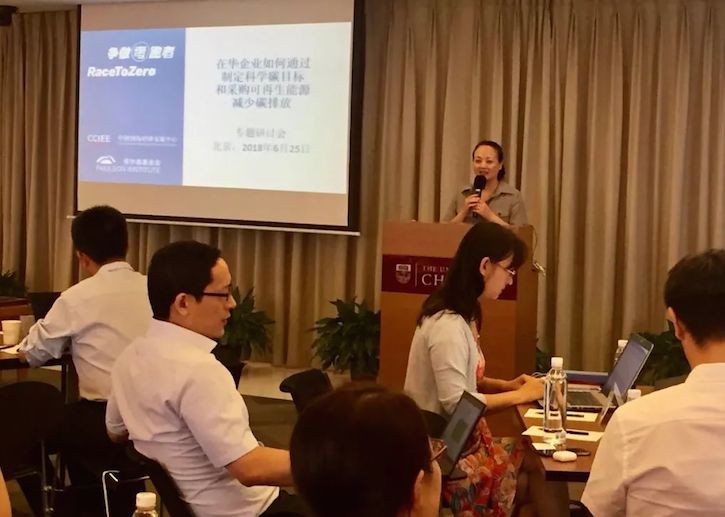
The Paulson Institute and the China Center for International Economic Exchanges held a workshop about corporate renewable energy procurement and the role of setting Science-based Targets (SBT) to reduce greenhouse gas emissions. The workshop was part of the Race to Zero initiative, which aims to encourage companies to take actions toward zero-carbon, zero-waste business practices.
Using renewable energy in corporate operations and throughout supply chains is one tool that companies have to transition to a low-carbon growth model. How companies can effectively procure renewable energy in China under the current policy framework and market conditions is a key question.

Fifty participants from the business community attended the workshops at which experts and officials from the National Development and Reform Commission’s (NDRC) Energy Research Institute, the World Wide Fund (WWF), and the Rocky Mountain Institute (RMI) and discussed key topics such as market status, challenges, trends, and the policy environment in China for procuring renewable energy and setting SBTs. The following are five insights from the presenters.
5 Things to Know
- Options for procuring renewable energy in China: Currently, the most common ways to procure renewable energy in China are through purchasing renewable energy certificates (otherwise known as “green certificates”) and purchasing electricity from distributed solar and wind power. The producer’s returns depend on local wind and solar resources and feed-in tariffs. Direct power purchasing such as direct investment into renewable energy generation plants is in its infancy in China with only a small number of projects in existence. Virtual power purchase agreements are not yet being used.
- Evolving market conditions: The economics of renewable electricity procurement are complex but also rapidly evolving. Given that the feasibility of procuring renewable energy varies widely across geographies and industries, some companies have little choice but to purchase green certificates. As market and policy conditions change, it is expected that new options to procure renewable energy will also increase, potentially at more cost-competitive price points. The situation is also complex for companies generating electricity from renewable sources. They may sell their electricity to users directly, sell through the power grid to an end-user, or sell all of it onto the grid. However, each option has its own challenges depending on the geography and market of the company generating the electricity.
- Quota-based target setting: China’s national energy regulators formulate regional quotas, leaving the local provincial governments and relevant energy authorities to draw up implementation plans. Each company’s targets can be preliminarily set according to the renewable energy quota in each province in China. Currently quotas are mainly imposed on producers, large direct purchasers, and end users. End users who participate in the electricity market are also subject to quota obligations.
- The challenge of direct purchasing: There are two ways for direct power purchasing: intra-provincial and inter-provincial. Coordination among the local power authorities, local NDRC bureaus, and various offices representing the local interests of the Ministry of Industry and Information Technology is absolutely essential for either type of purchase. As the service provider the grid does not have the final authority on those agreements. When multiple provinces are involved, interagency coordination is even more important – and difficult – as inter-provincial barriers are higher than those within a province. At present, only users in Shandong province are free to purchase electricity from outside the province. To purchase electricity from other provinces, buyers must ensure it is 100% derived from sources considered as “clean energy”. However, the way that the grid dispatches electricity means that it is difficult to meet this requirement in practice.
- Set Science-based Targets: The SBT Initiative aims to equip companies to set emissions reduction targets so as to limit global temperature rise within 2˚C. This, in turn, enhances companies’ competitiveness in the global transition to a low-carbon growth model by positioning them to develop new markets, drive innovation, reduce costs through improved efficiency, mitigate regulatory risk, and boost investor confidence. Setting SBTs is an emerging practice and the definition of what constitutes an SBT is evolving; however, there are currently a handful of methods available to set SBTs, with some methods being more applicable to certain companies and sectors. Consequently, interested companies may want to consider consulting SBT partner organizations to identify a suitable approach.





